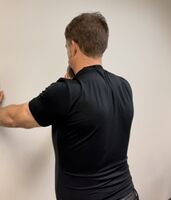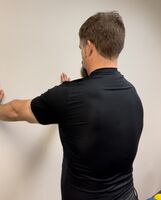Push Up Plus Exercise
Original Editor - Matt Huey
Top Contributors - Matt Huey, Chelsea Mclene and Kim Jackson
Introduction[edit | edit source]
The push up plus exercise is often utilized with people experience shoulder dysfunctions or pathologies. It is used due to the activation of the serratus anterior and improving scapular kinematics[1][2]. Often, if participants have increased upper trapezius activity and decreased serratus anterior activity there is more anterior tipping and medial rotation of the scapula and decreased upward rotation with elevation[3]. Increasing activation of the serratus anterior has been found to improve this upward rotation of the scapula. Utilizing the push up plus has been found to improve pain symptoms with people having impingement symptoms[3] and scapular winging[4].
Technique[edit | edit source]
Unlike a regular push up, in which the person is supported on both hands and toes on the floor, then lowers their body to the floor and returns. The push up plus is performed in the same starting position as a push up, with the arms extended but instead of lowering to the floor, the participant protracts their scapula.[5]
Progression[edit | edit source]
- Wall
Participant stands near a wall, extends arms, and leans forward into the wall. This position limits the weight bearing on the upper extremity and is often a starting point for participants
- Table
Participant is in an inclined position on a table or firm surface. This adds increased weight bearing through the upper extremity
- Quadruped
Participant is on knees with arms extended to add more resistance through the upper extremity.
- Push up position
Participant is in the push up position with arms extended and on toes.
- Resistance
Participant assumes any desired position but a resistance band can be wrapped around the trunk from the hands to add increased force on the upper extremity.
References[edit | edit source]
- ↑ Ludewig, P. M., Hoff, M. S., Osowski, E. E., Meschke, S. A., & Rundquist, P. J. (2004). Relative balance of serratus anterior and upper trapezius muscle activity during push-up exercises. The American journal of sports medicine, 32(2), 484–493.
- ↑ Hardwick, D. H., Beebe, J. A., McDonnell, M. K., & Lang, C. E. (2006). A comparison of serratus anterior muscle activation during a wall slide exercise and other traditional exercises. The Journal of orthopaedic and sports physical therapy, 36(12), 903–910.
- ↑ 3.0 3.1 Ludewig, P. M., & Cook, T. M. (2000). Alterations in shoulder kinematics and associated muscle activity in people with symptoms of shoulder impingement. Physical therapy, 80(3), 276–291.
- ↑ Park, K. M., Cynn, H. S., Kwon, O. Y., Yi, C. H., Yoon, T. L., & Lee, J. H. (2014). Comparison of pectoralis major and serratus anterior muscle activities during different push-up plus exercises in subjects with and without scapular winging. Journal of strength and conditioning research, 28(9), 2546–2551.
- ↑ Lunden JB, Braman JP, LaPrade RF, Ludewig PM. Shoulder kinematics during the wall push-up plus exercise. Journal of shoulder and elbow surgery. 2010 Mar 1;19(2):216-23.
- ↑ BSR Physical Therapy. Push up Plus. Available from: https://www.youtube.com/watch?v=YTAyc2uf_d0 (last accessed 5/2/23)
- ↑ Performance U. Push up Plus. Available from: https://www.youtube.com/watch?v=ALzFr2GT-Is (last accessed 5/2/23)








